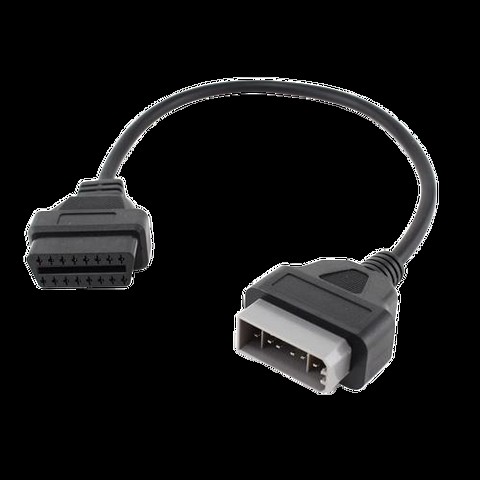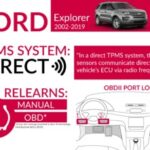Navigating the world of vehicle diagnostics can be confusing, especially when dealing with older trucks. You might be wondering, “Can I use a modern OBD2 scanner on my classic OBD1 truck?” The short answer is, not directly. However, with the right approach and equipment, you can indeed bridge this diagnostic gap. Let’s explore how.
Understanding OBD1 and OBD2 Differences
OBD, which stands for On-Board Diagnostics, is a system that vehicles use to monitor and report on their performance and health. The first generation, OBD1, was implemented in vehicles up until the mid-1990s, although some models even as late as 2006 still used it. OBD2, the standardized successor, became mandatory in the USA in 1996 and progressively worldwide.
The crucial difference lies in standardization and capability. OBD1 systems were manufacturer-specific, meaning each car maker could have their own diagnostic protocols and connector types. This lack of uniformity made diagnostic tools less versatile. OBD2 brought standardization, featuring a universal connector, standardized diagnostic trouble codes (DTCs), and a broader range of parameters that could be monitored. This leap forward made vehicle diagnostics more accessible and efficient.
The Challenge: OBD2 Scanners and OBD1 Trucks
A standard OBD2 scanner is designed to communicate with vehicles using OBD2 protocols. OBD1 trucks, by their nature, operate on different, manufacturer-specific protocols. Therefore, directly plugging an OBD2 scanner into an OBD1 port will not establish communication. The scanner simply won’t understand the signals from the truck’s computer. Even if your OBD1 truck happens to have a 16-pin connector that physically resembles an OBD2 port, it doesn’t mean it’s OBD2 compliant. Many older vehicles with this type of connector still operate on OBD1 protocols.
The Solution: Adapters and OBD1-Compatible Scanners
To use a modern diagnostic approach on an OBD1 truck, you have two primary options:
-
Using an OBD1 to OBD2 Adapter: An adapter cable can physically connect an OBD2 scanner to an OBD1 port. However, it’s crucial to understand that an adapter only changes the connector shape. It does not magically convert an OBD1 vehicle to OBD2. For an OBD2 scanner to work in this setup, it must be capable of understanding and communicating with OBD1 protocols. Many basic, inexpensive OBD2 scanners lack this capability.
-
Employing an OBD1 and OBD2 Compatible Scanner: The most effective solution is to use a professional-grade scan tool that is specifically designed to read both OBD1 and OBD2 protocols. These scanners are equipped with the necessary software and hardware to communicate with a wide range of vehicles, including older OBD1 systems. When using such a tool, you may still need an adapter cable depending on the specific OBD1 port type on your truck.
Identifying Your Truck’s OBD System and Port
Before attempting any diagnostic procedure, it’s essential to identify whether your truck is truly OBD1 and to locate its diagnostic port. For OBD1 vehicles, the port is often found in one of these locations:
- Under the dashboard on the driver’s side: This is a common location for many OBD1 ports.
- In the engine bay: Some OBD1 systems, particularly in older Japanese vehicles, have the diagnostic port located under the hood.
Visually inspecting the port can also give clues. OBD1 ports come in various shapes and pin configurations, often different from the standard 16-pin OBD2 port. For example, older Nissan vehicles might use a 14-pin connector, and Toyota vehicles could have a 22-pin port in the engine bay.
Nissan 14-pin adapter cable, often required for diagnosing older Nissan vehicles with OBD1 systems.
Toyota OBD1 22-pin port commonly found in the engine bay of older models.
In contrast, the OBD2 port is a standardized 16-pin connector, usually located under the dashboard on the driver’s side.
A standard OBD2 port, the universal interface for modern vehicle diagnostics.
Choosing the Right Adapter and Scanner
If you determine your truck is OBD1, and you wish to use an OBD2 scanner (or a modern scan tool), selecting the correct adapter is crucial. Adapters are specific to the manufacturer and OBD1 port type. For instance, if you have an older Nissan with a 14-pin OBD1 port, you’ll need a Nissan 14-pin to OBD2 adapter. Similarly, for a Toyota with a 22-pin OBD1 port, a Toyota 22-pin to OBD2 adapter is necessary.
The Toyota 22-pin OBD1 adapter, essential for connecting modern scanners to older Toyota vehicles.
Remember, the adapter is only half the solution. Your scanner must also be capable of reading OBD1 protocols. Look for scan tools that explicitly state OBD1 compatibility in their specifications. Investing in a scanner that handles both OBD1 and OBD2 provides versatility, allowing you to work on a wider range of vehicles, both old and new.
Conclusion
While you can’t directly use a standard OBD2 scanner on an OBD1 truck, you can effectively perform diagnostics by using the correct adapter and, more importantly, an OBD1-compatible scan tool. Understanding the differences between OBD1 and OBD2, identifying your truck’s OBD system, and choosing the right equipment are key steps in successfully diagnosing your classic truck. With the right approach, you can bring modern diagnostic capabilities to even the most seasoned vehicles.

